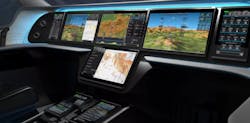PHOENIX, Ariz., - The first question many pilots have when they learn about Honeywell’s new Anthem avionics platform and its cloud-connected capabilities is how avionics with access to the internet can be kept secure. Anthem doesn’t just let pilots share data via the internet but also runs a browser on flight deck displays so pilots can access some of their favorite software while in the air and connected to the internet, Matt Thurber reports for AIN Online. Continue reading original article.
The Military & Aerospace Electronics take:
11 May 2022 - Honeywell Anthem is designed to solve two problems facing the aviation industry. First, it creates ways for increasingly complex aircraft to function with more autonomy, relieving stress on pilots and promoting safety and efficiency. Second, it enables the disjointed systems that support an aircraft to work together more seamlessly to deliver critical information to pilots.
Honeywell Anthem supports growing levels of aircraft autonomy, leading to complete autonomous capabilities in the future as regulations allow. Enabling increasing levels of autonomy — whether it’s automating manual tasks for single-pilot operation or automating more complex processes to reduce workload across all pilots, maintainers and other service providers in a large fleet — depends heavily on improving connectivity across aircraft systems.
Historically, mechanics and pilots had to be on board aircraft with wired connections to transfer critical data like maintenance status and flight plans. Honeywell Anthem allows for this data transfer without needing to be physically near the aircraft. Additionally, individual support systems (fuel, maintenance, catering, etc.) have also been disjointed, forcing pilots to interface with multiple third-party apps, websites and businesses both pre-flight and post-flight. The pilot used to be required to integrate all this critical incoming information and then provide notifications to numerous support personnel prior to, during and after completing a flight.
Jamie Whitney, Associate Editor
Intelligent Aerospace

